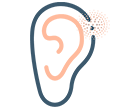Syndromic and Nonsyndromic Deafness Precision Panel
Hearing loss can be defined as conductive or sensorineural. Conductive hearing loss occurs due to dysfunction of the outer or middle ear, which prevents transmission of sound waves from reaching the inner ear.




